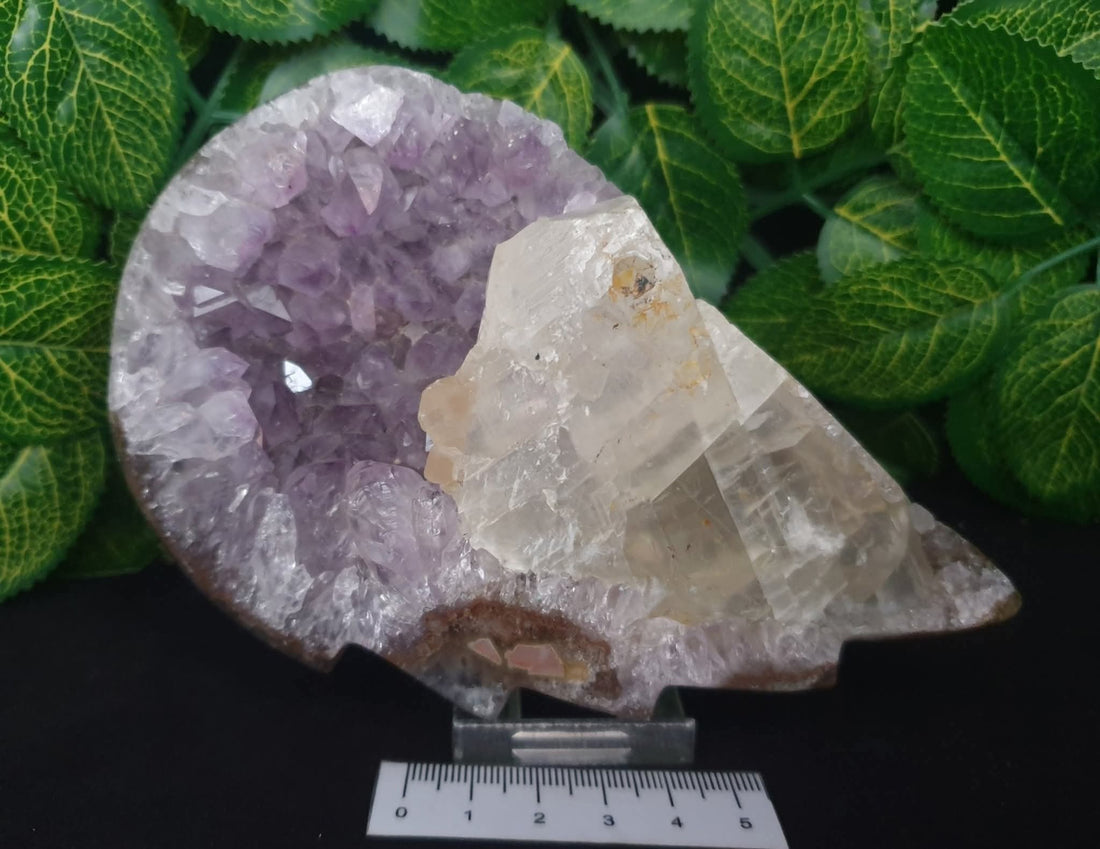
Amethyst: The Science and Spectrum of Nature’s Purple Quartz
Share
Amethyst is a crystalline variety of quartz (SiO₂) celebrated for its vibrant purple hues and widespread geological presence. As a member of the silicate mineral family, amethyst forms in igneous and metamorphic environments and is valued for both its aesthetic appeal and scientific significance. Its colour, ranging from pale lilac to deep violet, is primarily due to trace amounts of iron and natural irradiation within the crystal lattice.
Geological Formation and Properties
Amethyst typically forms in hydrothermal veins and geodes, where silica-rich fluids deposit quartz crystals over time. The purple colouration arises when iron impurities are incorporated into the quartz structure and subsequently exposed to gamma radiation from surrounding rocks. This process alters the oxidation state of iron, producing the characteristic violet tones.
Key physical properties include:
-
Chemical formula: SiO₂ (silicon dioxide)
-
Crystal system: Trigonal
-
Hardness: 7 on the Mohs scale
-
Transparency: Transparent to translucent
-
Lustre: Vitreous
Amethyst is commonly found in Brazil, Uruguay, Madagascar, Russia, and Australia, with each locality producing specimens of distinct colour saturation and crystal habit.
Scientific Significance
Amethyst is an important mineral in geological research due to its formation, composition, and crystal behaviour. It contributes to our understanding of:
-
Mineral growth in geodes and cavities
-
Trace element incorporation in quartz
-
Natural irradiation effects on crystal colouration
-
Crystallographic variations across geological environments
Its widespread occurrence and distinct colour make it a valuable specimen for mineralogical classification, educational collections, and analytical studies.
Cultural Significance
Amethyst has held symbolic and practical value across civilisations for thousands of years. In ancient Greece, it was believed to prevent intoxication—its name derives from the Greek amethystos, meaning “not drunk.” The stone was carved into drinking vessels and worn as amulets.
Throughout history, amethyst has been associated with royalty, spirituality, and protection. It has appeared in religious artefacts, ceremonial jewellery, and folklore across Europe, Asia, and the Americas. Today, it continues to be appreciated for its beauty and historical resonance.
Metaphysical Significance
In metaphysical practice, amethyst is considered a stone of clarity, calm, and spiritual connection. It is commonly used to support meditation, enhance intuition, and balance emotional energy. Different varieties are thought to resonate with specific energetic properties—for example:
-
Chevron Amethyst is used for insight and inner clarity
-
Vera Cruz Amethyst is valued for high-frequency spiritual work
-
Pink Amethyst is associated with emotional healing and heart energy
-
Black Amethyst is believed to offer grounding and protection
While these interpretations are not scientifically verified, they remain meaningful to many collectors, healers, and spiritual practitioners.
Crystal World’s Amethyst Range
Crystal World offers a diverse and scientifically fascinating selection of amethyst varieties and products, each with unique geological and aesthetic characteristics:
Chevron Amethyst
-
Distinctive V-shaped bands of white quartz and purple amethyst
-
Formed through layered deposition during fluctuating mineral-rich fluid flow
Black Amethyst
-
Deep, nearly opaque purple-black crystals with hematite inclusions
-
High iron content and dense crystal growth
Pink Amethyst
-
Soft pink hues due to hematite and manganese
-
Found in Patagonia, Argentina
Vera Cruz Amethyst
-
Pale lavender colour, high clarity, and elongated laser-like crystals
-
Sourced from hydrothermal veins in Veracruz, Mexico
Dragon’s Tooth Amethyst
-
Large, pointed crystals resembling dragon fangs
-
Rapid crystal growth in open cavities
Dog Tooth Amethyst
-
Sharp, jagged crystal points often found in clusters
-
Formed in geodes with vertical growth patterns
Amethyst Jewellery and Collectibles
In addition to raw specimens, Crystal World offers a range of amethyst jewellery and polished forms:
-
Cabochons: Smooth, polished stones ideal for rings, earrings, and pendants
-
Pendants: Handcrafted pieces showcasing natural and polished amethyst
-
Bracelets: Beaded and wire-wrapped designs combining style with energetic appeal
-
Generators: Polished six-sided points used to focus and amplify energy
-
Caves (Geodes): Large hollow formations lined with amethyst crystals, often used in interior design, education, and metaphysical practice
Amethyst caves, also known as cathedrals, form when gas bubbles in volcanic rock are filled with mineral-rich fluids that crystallise over time. These stunning natural chambers offer insight into mineral deposition, crystal growth rates, and geochemical conditions.
Conclusion
Amethyst is more than a beautiful gemstone—It reflects the intricate interplay of heat, pressure, and time beneath the Earth’s surface.. Crystal World’s curated range showcases the mineral’s diversity, from the layered elegance of Chevron Amethyst to the rare vibrancy of Vera Cruz and Pink Amethyst. Whether in raw form, polished into jewellery, or displayed as a towering geode, each specimen offers a unique glimpse into Earth’s mineralogical processes and the enduring allure of natural crystal formation.
References
Geology Science – geologyscience.com
Rock Chasing – rockchasing.com
Science Trends – sciencetrends.com
Crystal World Australia – crystalworld.com.au